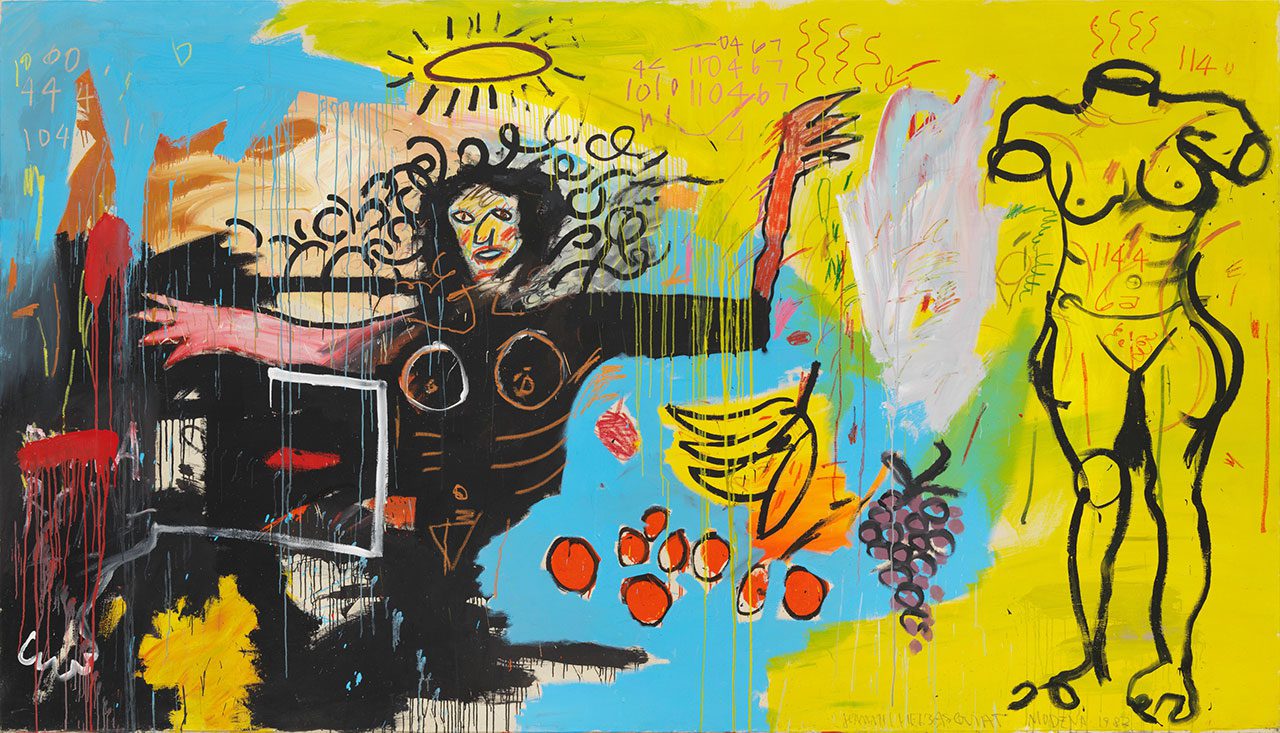ART CITIES: Paris-Jean Michel Basquiat
 Following the waves of Minimalism and Conceptual art at the end of the 20th Century, Jean-Michel Basquiat stood out as a figurative painter. At that moment figuration was a discredited genre and seemed spent. However, from the very start, Basquiat set himself the challenge of giving existence to the Black Figure – Ralph Ellison’s “Invisible Man”- in the social and cultural space.
Following the waves of Minimalism and Conceptual art at the end of the 20th Century, Jean-Michel Basquiat stood out as a figurative painter. At that moment figuration was a discredited genre and seemed spent. However, from the very start, Basquiat set himself the challenge of giving existence to the Black Figure – Ralph Ellison’s “Invisible Man”- in the social and cultural space.
By Efi Michalarou
Photo: Gagosian Archive
The exhibition “Venus”, is a pairing of two rarely seen masterpieces from different millennia: “Untitled” (1982), a significant painting from Jean-Michel Basquiat’s acclaimed “Modena” series, is shown in dialogue with an Imperial Roman sculpture of the goddess Venus loaned from the Torlonia Collection in Rome, the world’s largest private collection of Roman art. Highlighting how Venus has been a muse across centuries, the exhibition offers an uncommon gallery setting for classical and contemporary masterworks in central Paris. “Untitled” is one of eight large-scale paintings that Basquiat made in Modena, Italy, in the summer of 1982 at the age of twenty-two. Produced at the invitation of collector and art dealer Emilio Mazzoli for an exhibition that never came to fruition, the works were not shown together until they were reunited last summer at Fondation Beyeler in Riehen/Basel, more than four decades after they were made. The paintings that comprise the “Modena” series are some of the most expressive and vivid of Basquiat’s career; ripe with ideas and complexity, they collectively give the impression of an opera with multiple acts. With heavy, dripping brushstrokes and compositions dominated mostly by single figures, the canvases share a fiery, emotional intensity, conveying a dynamic narrative told through the impassioned gestures of the main characters: angel, devil, prophet, miser, farmhand, and Venus. Untitled is the only work from the series to feature a female figure and alludes most directly to classical mythology. Before his stay in Modena, Basquiat traveled to Rome with Suzanne Mallouk, his girlfriend at the time, whom the artist was known to call “Venus.” The artist’s connections to Mallouk as companion and muse suggest a personal meaning to this work beyond its engagement with Venus as archetype. “Untitled” unites Basquiat’s command of color and energetic composition with references to art of the past. Two female figures emerge from passages of vigorously applied teal, yellow, and black paint amid cipher-like marks and numerals. The work recalls Sandro Botticelli’s “The Birth of Venus” (c. 1485), while the figures’ starkly abstracted features play off the Cubist innovations of Pablo Picasso’s “Les Demoiselles d’Avignon” (1907), as does the still life of fruit arrayed between them. The exhibition juxtaposes Basquiat’s painting with a remarkable marble statue of Venus from Imperial Rome, on loan from the Torlonia Collection, Rome, which is considered the most important private collection of Roman art in the world. Through its activity, the foundation aims to preserve and promote this cultural legacy for future generations. Holding a robe that drapes around her hips, the elegant standing figure resembles that of the Capitoline Venus—a representation of the goddess that ultimately derives from the work of Praxiteles, the Athenian regarded as the first artist to sculpt a life-size female nude
Photo: Jean-Michel Basquiat, Untitled, 1982, Acrylic and oil stick on canvas, 94 7/8 x 165 1/4 inches (241 x 419.7 cm), © Estate of Jean-Michel Basquiat. Licensed by Artestar, New York, Photo: Stefan Altenburger, Courtesy Gagosian
Info: Gagosian, 9 rue de Castiglione, Paris, France, Duration: 17/10-20/12/2024, Days & Hours: Tue-Sat 10:30-18:30, https://gagosian.com/
